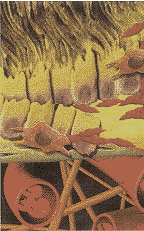眼视光学杂志 1999年第2期第1卷 新技术介绍
作者:Steven Lam
美国65岁以上老年人中大约有10%会发生早期年龄相关性黄斑变性(aged-related macular degeneration,简称AR-MD),其中6%将是严重类型的ARMD。严重类型ARMD的典型表现为脉络膜新生血管化(choroidal neovascularization,简称CNV)。CNV会使病人视力迅速下降,多数患者在确诊两年内变盲。因此,CNV已成为当今老年致盲的主要原因。激光光凝虽然可以延缓轻微CNV的发展,但患者的健康视网膜却会被光凝损伤而导致视力迅速下降,而且其中5%还会复发。本文介绍一种新的、具有选择性的CNV治疗方法———应用verteporfin(PBD-MA)的光动力疗法(photodynamic therapy,简称PDT)。这种疗法能阻止脉络膜新生血管化进程,因此对ARMD病人的视力有保护作用。
1 verteporfin光动力疗法 治疗的两个阶段:①静脉注入经高选择性光敏微脂粒染色的verteporfin(10分钟6mg/m2);②以非致热性激光激活眼部血管中的染料,异常脉络膜血管得以破坏而正常血管不受影响。
2 作用机制 微脂粒verteporfin一进入血中即与低密度脂蛋白(LDL)混合形成LDL-V,而LDL-V又被具有高浓度LDL受体的异常脉络膜血管上皮细胞吞噬。注射过程约需1分30秒。注射15分钟后verteporfin即被红光(689nm,50J/cm2)激活。由于激光不产生热量,故视网膜并不受损。光化学反应产生的氧自由基会损害上皮细胞。后者能激活血小板并阻塞异常血管,但视网膜血管则不受治疗的影响。verteporfin光动力疗法虽不能使已经受损的光感受器和视网膜细胞复原,但却能通过限制CNV蔓延而维持视力,甚至还能使视力得以短期性提高(原因可能是视网膜下液体减少)。
3 预期结果 早期的研究显示,verteporfin光动力疗法可阻止CNV的发展并防止异常血管渗漏。更重要的是研究还表明,在3个月的随访期内,病人的视力已经稳定。该项技术仍处于试验阶段,目前正在对ARMD或近视性改变的病人进行大规模跨国广泛性Ⅲ期测试:①光动力疗法治疗ARMD(treatment of AMD with PDT,简称TAP试验)将于1999年获得初步成果;②2000年将获得使用verteporfin光动力疗法(verteporfin in photodynamic therapy,简称VIP试验)的初步成果。
上述研究的目的是探讨用verteporfin光动力疗法治疗ARMD继发典型和潜隐性CNV病人的可能性。
Age-related macular degeneration(ARMD)and Photodynamic therapy(PDT)
Steven Lam
Clinical development remains promising for photodynamic therapy(PDT)with verteporfin(BPD-MA),a new,selective treatment for choroidal neovascularization(CNV)associated with age-related macular degeneration(ARMD)-the major cause of blindness in the elderly[1]. The technique has the potential to prevent the progression of CNV and thereby preserve patients’vision.
Current status:Disease and treatment
Approximately 10% of people aged over 65 years in the US have early-stage ARMD[2],and,as the average age of the population rises,the number of people with the disease is set to triple in the next 25 years[3]. The more severe form of ARMD,which is characterized by CNV,may affect up to 6% of patients[4,5].CNV causes rapid deterioration in vision and most affected patients’ eyes are classified legally blind within two years of diagnosis[1]. Laser photocoagulation helps prevent the progression of CNV in patients who have small,discrete lesions,but this group accounts for only 10%~20% of the total number of patients with CNV[3,6,7]. Photocoagulation is also limited because it destroys healthy retinal tissue and patients pay the price of an immediate loss of visual acuity following treatment in return for slower disease progression[3,8,9]. In addition 50% of patients treated with laser photocoagulation suffer from recurrences[9].
  
Fig1 In neovascular ARMD abnormal blood cells penetrate the weakened Bruch’s membrane
1 PDT with verteporfin
The procedure takes place in two stages:[10]
.A highly selective photosensitizing dye-liposomal verteporfin is administered intravenously(6mg/m2 over 10 minutes).
.The dye is activated in the eye using anon-thermal laser,resulting in the destruction of abnormal choroidal blood vessels,leaving normal vessels still functional.
2 Howitworks
Once in the bloodstream liposomal verteporfin complexes with lowdensity lipoprotein(LDL). The newly formed LDL-verteporfin is taken up by the endothelial cells of the abnormal choroidal blood vessels,which have high levels of LDL-receptors. Verteporfin is then activated with red light(689nm,50J/cm2)applied 15 minutes after the start of the infusion for 1.5 minutes[10]. As the laser does not generate heat the overlying retina is not harmed by the technique.
  
Fig2 Verteporfin concentrating in the endothelial cells of the neovasculature in the degenerating macula.
Oxygen free radicals released during the photochemical reaction cause endothelial cellular disruption which,in turn,leads to platelet activation and occlusion of the abnormal blood vessels. Retinal vessels are unaffected by the treatment. PDT with verteporfin cannot restore damaged photoreceptors or damaged retinal cells,but it may maintain vision by confining the spread of CNV. A short term improvement in vision may be observed,probably due to the reduction of subretinal fluid.
3 Promising results
Early studies demonstrate that PDT with verteporfin stems the growth of CNV and prevents leakage from abnormal blood vessels[10,11]. Most importantly,these studies suggest that patients’ sight stabilizes and does not deteriorate during the three month follow-up period. The technique is still an investigational procedure and is undergoing extensive Phase Ⅲ testing in patients with ARMD or myopic lesions in large-scale multi-national studies:
[1] [2] 下一页 |
